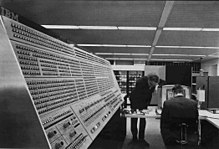IBM initially announced a series of six computers and forty common peripherals. IBM eventually delivered fourteen models, including rare one-off models for NASA. The cheapest model was the S/360-20 with as little as 4 K of core memory, eight 16-bit registers instead of the sixteen 32-bit registers of real 360s, and an instruction set that was a subset of that used by the rest of the range. (The Model 20 was suited for smaller businesses — yet it had the IBM name and salesforce.)
The initial announcement in 1964 included Models 30, 40, 50, 60, 62, and 70. The first three were low- to middle-range systems aimed at the IBM 1400 series market. All three were sold first during mid-1965. The last three, intended to replace the 7000 series machines, were never sold and were replaced by the 65 and 75, which was first delivered during November 1965, and January 1966, respectively.
Later additions to cheaper models included the 20 (1966, mentioned above), 22 (1971), and 25 (1968). The Model 22 was a recycled Model 30 with minor limitations: a smaller maximum memory configuration, and slower I/O channels which limited it to slower and lower-capacity disk and tape devices than on the 30.
The Model 44 (1966) was a variant aimed at the mid-range scientific market with hardware floating point but an otherwise limited instruction set.
A succession of high-end machines included the 67 (1966, mentioned below, briefly anticipated as the 64 and 66), 85 (1969), 91 (1967, anticipated as the 92), 95 (1968), and 195 (1971). The 85 design was intermediate between the System/360 line and the follow-on System/370 and was the basis for the 370/165. There was a System/370 version of the 195, but it did not include Dynamic Address Translation.
The implementations differed substantially, using different native data path widths, presence or absence of microcode, yet were extremely compatible. Except where specifically documented, the models were architecturally compatible. The 91, for example, was designed for scientific computing and provided out-of-order instruction execution (and could yield "imprecise interrupts" if a program trap occurred while several instructions were being read), but lacked the decimal instruction set used in commercial applications. New features could be added without violating architectural definitions: the 65 had a dual-processor version (M65MP) with extensions for inter-CPU signalling; the 85 introduced cache memory. Models 44, 75, 91, 95, and 195 were implemented with hardwired logic, rather than microcoded as all other models.
The S/360-67, announced in August 1965, was the first production IBM system to offer dynamic address translation hardware to support time-sharing. "DAT" is now more commonly referred to as anMMU. An experimental one-off unit was built based on a model 40. Before the 67, IBM had announced models 64 and 66, DAT versions of the 60 and 62, but they were almost immediately replaced by the 67 at the same time that the 60 and 62 were replaced by the 65. DAT hardware would reappear in the S/370 series in 1972, though it was initially absent from the series. Like the 65 to which it was closely related, the 67 also had a dual-CPU implementation.
All System/360 models were withdrawn from marketing by the end of 1977.
Backward compatibility
IBM's existing customers had a large investment in software that executed on second generation machines. Many models offered the option of emulation of the customer's previous computer (e.g. theIBM 1400 series on a 360-30 or the IBM 7094 on a 360-65) using a combination of special hardware, special microcode and an emulation program that used the emulation instructions to simulate the target system, so that old programs could run on the new machine. However, customers had to halt the computer and load the emulation program. The 360/85 and later System/370 retained the emulation options, but allowed them to be executed under operating system control alongside native programs.
Successors and variants
The S/360 (excepting the 360/20) was replaced by the compatible System/370 range in 1970 and 360/20 users were targeted to move to the IBM System/3. (The idea of a major breakthrough with FS technology was dropped in the mid-1970s for cost-effectiveness and continuity reasons.) Later compatible IBM systems include the 3090, the ES/9000 family, 9672 (System/390 family), the zSeries,System z9, System z10 and IBM zEnterprise System.
Computers that were mostly[NB 1] identical or compatible in terms of the machine code or architecture of the System/360 included Amdahl's 470 family (and its successors), Hitachi mainframes, theUNIVAC 9200/9300/9400 series, the English Electric System 4, and the RCA Spectra 70 series, which was sold to what was then UNIVAC to become the UNIVAC 90/60 and later releases. The Soviet Union produced an S/360 clone named the ES EVM.
The IBM 5100 portable computer, introduced in 1975, offered an option to execute the System/360's APL.SV programming language through a hardware emulator. IBM used this approach in order to avoid the costs and delay in creating a version of APL specific to the 5100.
Special radiation-hardened and otherwise somewhat modified S/360s, in the form of the System/4 Pi avionics computer, are used in several fighter and bomber jet aircraft. In the complete 32-bit AP-101 version, 4 Pi machines are used as the replicated computing nodes of the fault-tolerant Space Shuttle computer system (in five nodes). The U.S. Federal Aviation Administration operated the IBM 9020, a special cluster of modified System/360s for air traffic control, from 1970 until the 1990s. (Some 9020 software is apparently still used via emulation on newer hardware.)


0 comments:
Post a Comment